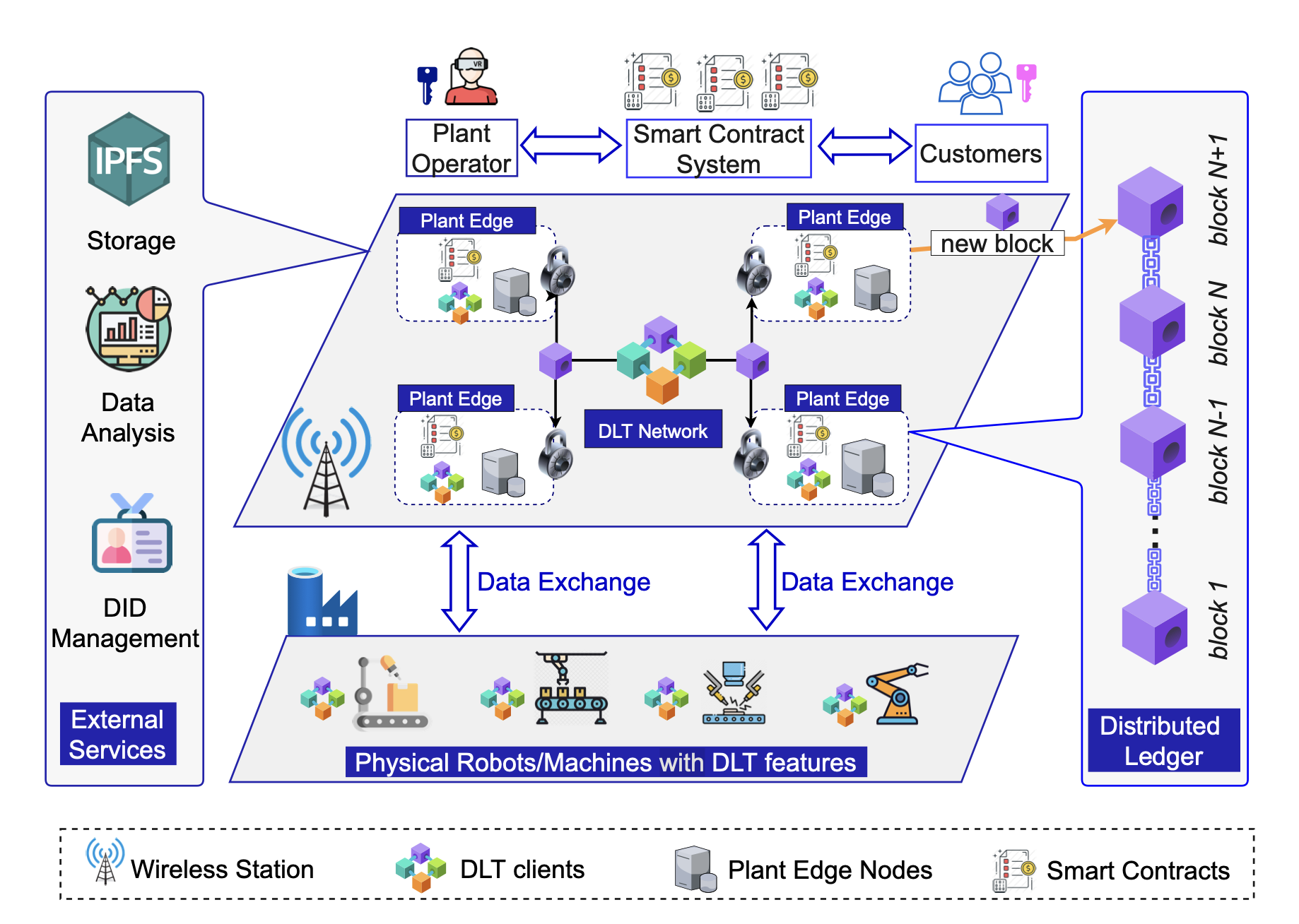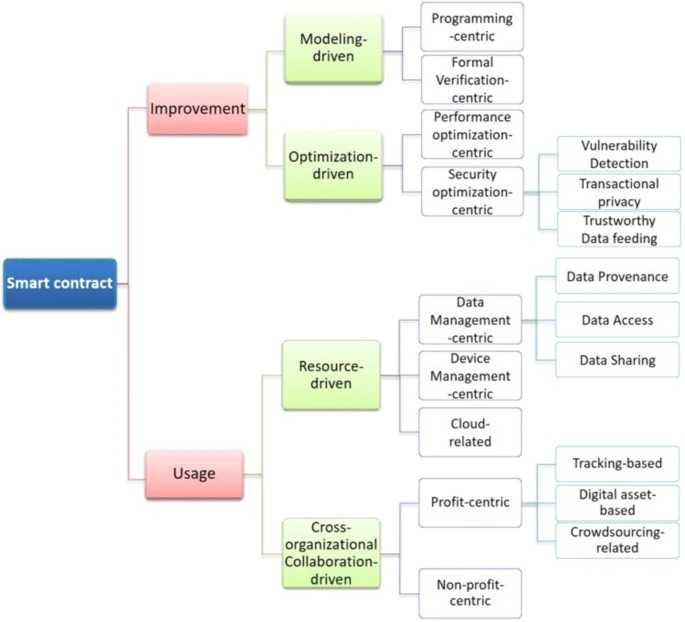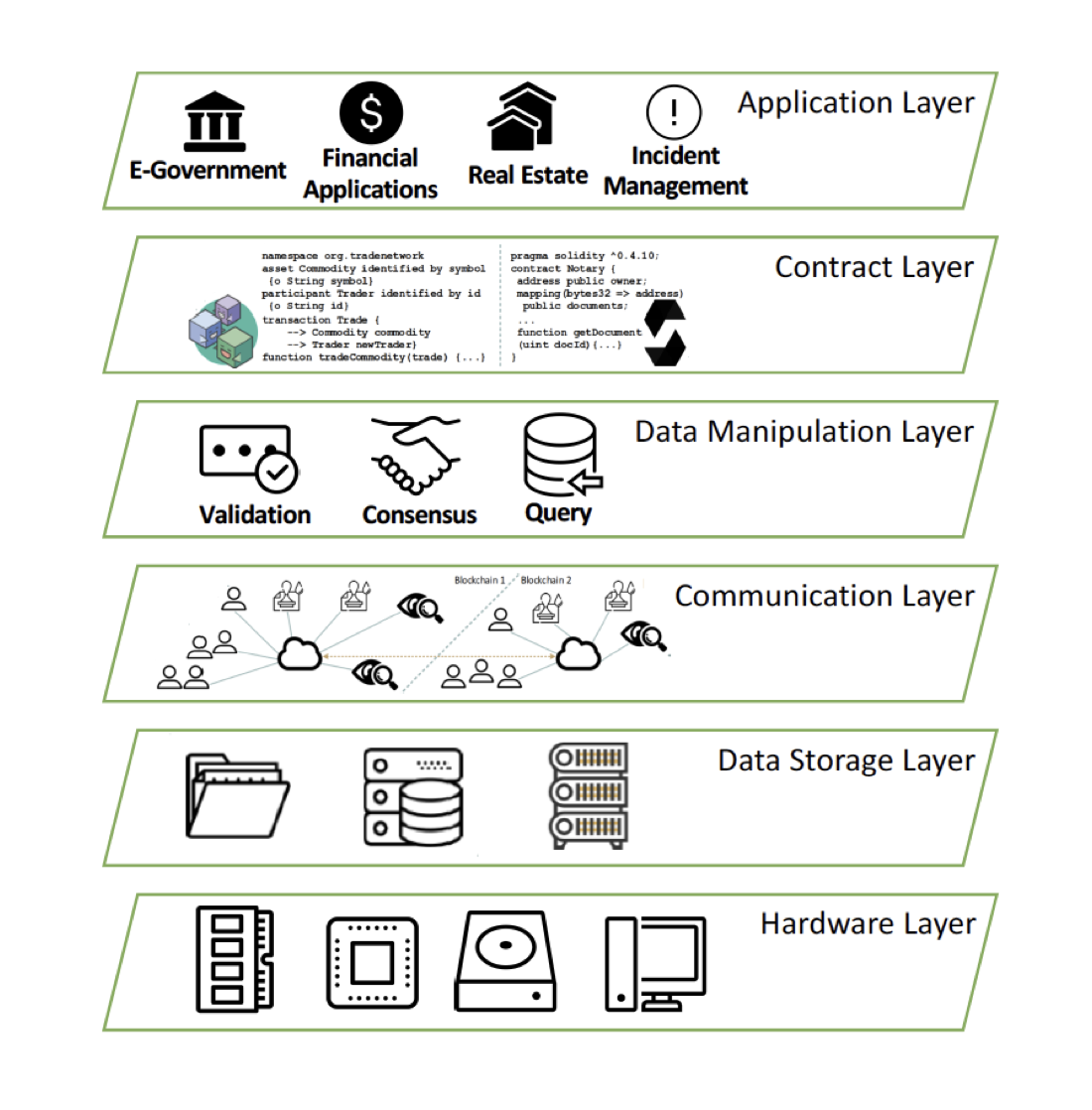Blockchain technology has emerged as a transformative force in the digital world, revolutionizing how organizations operate and interact. By enhancing trust, security, and transparency, blockchain technology significantly improves the traceability of data shared across a business network, thus fostering a more accountable and efficient system (IBM, 2022). The profound impact of blockchain development is manifold: it ensures transparency and immutability in data management, bolsters security through advanced cryptographic techniques, and promotes autonomy by enabling decentralization (Itech-Softsolutions, 2023). Furthermore, the blockchain’s decentralized architecture eliminates intermediaries, facilitating streamlined operations and reducing costs (Technology.org, 2023). This pivotal role underscores blockchain technology’s capacity to shape our digital future, offering a robust foundation for innovation and integration across various sectors.
I. Core Concepts of Blockchain Technology
The core concepts of blockchain technology, such as Distributed Ledger Technology (DLT), consensus mechanisms, and smart contracts, form the backbone of its revolutionary impact across various industries (El Ioini and Pahl, 2018). DLT operates as a decentralized database maintained collaboratively by multiple participants known as nodes. Each node holds a ledger copy, enhancing data integrity and transparency. However, DLT systems are often resource-intensive, as every node processes each transaction, and the consensus mechanisms required for transaction validation can introduce inefficiencies.

Figure 1: Overview of the System Design for using DLT in Industrial Manufacturing
Consensus mechanisms are critical for achieving agreement among the network’s nodes, ensuring the blockchain’s reliability and security (Yao et al., 2023). Different mechanisms present varying trade-offs affecting security, performance, and the degree of decentralization. For instance, Proof of Work (PoW) is highly secure but consumes substantial energy. In contrast, Proof of Stake (PoS) is more energy-efficient but may contribute to more significant centralization risks (Soltani et al., 2022).
Smart contracts, programmed as self-executing contracts whose terms are embedded in code, significantly reduce the necessity for intermediaries by automating business processes (Khan et al., 2021). Nonetheless, they are only as robust as the code they are built on; bugs can lead to unexpected outcomes, and their immutable nature cannot be easily altered post-deployment.

Figure 2: The proposed taxonomy of blockchain-enabled intelligent contracts (Khan et al., 2021)
From a business perspective, blockchain technology offers notable benefits, particularly regarding security, transparency, and efficiency. The decentralized and immutable nature of blockchain enhances security. It diminishes fraud risks, although the actual security level can depend significantly on specific implementations, such as the coding of smart contracts (Haugum et al., 2022). The transparency afforded by blockchain’s public ledger system increases transaction visibility and traceability, which builds trust among users but can raise privacy issues if sensitive data becomes too accessible. Moreover, blockchain can streamline operations through smart contracts and offer consistent data views, reducing reconciliation costs and speeding up transactions. However, these efficiency gains may be mitigated by the substantial computational and storage demands required to maintain a distributed ledger (Pal, Tiwari and Behl, 2021).
II. Essential Elements for Robust Blockchain Development
Developing robust blockchain systems is contingent on a holistic understanding and strategic integration of several key elements, each playing a pivotal role in enhancing performance, security, and functionality.
1. Architecture Design
A blockchain’s foundational architecture is vital for determining its overall efficacy and security. Critical considerations include selecting the appropriate type of blockchain—public, private, or consortium—based on the application’s specific needs. The architecture must also integrate suitable consensus mechanisms and innovative contract platforms to align with the desired outcomes of the blockchain system. The selection among public, private, or consortium blockchains hinges on the particular requirements of the use case. Each type offers distinct advantages and drawbacks concerning privacy, security, performance, and governance. Scalability remains a formidable challenge within blockchain systems, impacting transaction throughput and latency. Equally important is interoperability – the capability of various blockchain systems to communicate and exchange information seamlessly – which is essential for widespread adoption and functionality across different platforms and industries.
 Figure 3: Layers of a blockchain system (Tabatabaei, Vitenberg and Veeraragavan, 2023)
Figure 3: Layers of a blockchain system (Tabatabaei, Vitenberg and Veeraragavan, 2023)
2. Security Measures
An array of security measures is essential to safeguard these systems, including sophisticated encryption techniques and rigorous critical management practices. Regular audits and strict adherence to established security best practices are crucial for identifying and mitigating potential vulnerabilities, thereby maintaining the integrity and trustworthiness of the blockchain (Taherdoost, 2023). The creation of robust blockchain systems demands a comprehensive approach that meticulously considers each of these essential elements. Developers must also remain informed about the latest advancements and research in the field to continuously refine and enhance the security and functionality of blockchain technologies.
3. Consensus Protocols
Comparing different consensus protocols such as Proof of Work (PoW), Proof of Stake (PoS), and Delegated Proof of Stake (DPoS) reveals distinct impacts on blockchain performance and security. PoW, utilized by Bitcoin, ensures high security through computational challenges but suffers from scalability issues and high energy consumption. Conversely, PoS, which relies on validators holding stakes in the network, offers improved scalability and energy efficiency but may lead to centralization, as those with more significant stakes have more influence (Nguyen et al., 2019). DPoS further evolves PoS by delegating transaction validation to a small group of trusted nodes, enhancing transaction speed and efficiency. However, this delegation can introduce vulnerabilities related to centralization and potential collusion among validators (Yang et al., 2019). Thus, while PoW provides robust security, PoS and DPoS offer better performance, each with trade-offs in terms of decentralization and security risks (Yang et al., 2019), (Nguyen et al., 2019).

4. Smart Contracts
Developing secure and efficient intelligent contracts requires adherence to best practices and utilization of appropriate tools. Best practices include thorough code reviews, formal verification methods to ensure contract correctness, and implementing security patterns to prevent common vulnerabilities such as reentrancy attacks (Hu et al., 2020). Tools like SCStudio, which integrate real-time security recommendations and validation, significantly aid developers in producing secure contracts by providing continuous feedback and automated testing (Ren et al., 2021). Furthermore, adopting DevOps methodologies for smart contracts, including continuous integration and deployment, helps maintain high security and operational standards throughout the development lifecycle. These approaches collectively enhance the reliability and security of smart contracts, mitigating the risk of costly vulnerabilities (Hu et al., 2020), (Ren et al., 2021), (Reyes et al., 2023).
III. Challenges and Solutions in Blockchain Implementation
Blockchain implementation faces significant challenges, particularly in scalability and regulatory compliance. Scalability issues arise due to the resource-intensive nature of blockchain operations, which involve maintaining a giant, distributed ledger that requires substantial computational power and storage capacity. This limitation is especially critical for resource-constrained clients, who must rely on more capable nodes, potentially exposing them to security risks (Le, 2021). Regulatory challenges also loom large, as blockchain’s decentralized and immutable nature can conflict with existing legal frameworks, such as the GDPR, which mandate the ability to modify or delete personal data (Bernal Bernabe et al., 2019). Additionally, the lack of standardization and interoperability between blockchain platforms hinders seamless communication and data sharing among stakeholders, exacerbating implementation difficulties (Saxena et al., 2023).

Solutions to these challenges include the development of privacy-preserving techniques, such as self-sovereign identity models, and cryptographic constructions that enhance security and efficiency for resource-constrained devices. Creating standardized protocols and improving interoperability is crucial for advancing blockchain technology in various sectors. In conclusion, while blockchain holds transformative potential, addressing scalability and regulatory hurdles is essential for its widespread adoption and effective implementation.
IV. Future Outlook and Advancements
The future outlook and advancements in blockchain technology are poised to bring transformative changes across various sectors. Blockchain is predicted to evolve significantly, driven by the need for more secure, transparent, and efficient systems. For instance, private blockchains are gaining popularity due to their enhanced privacy and control, which is expected to dominate over public blockchains in the coming years (Kommadi, 2022). Integrating blockchain with other advanced technologies like AI and IoT is also anticipated to open new avenues for innovation, enhancing data security and operational efficiency (Maheshwari et al., 2023). Furthermore, blockchain technology will likely see substantial impacts from the energy sector, particularly in enabling peer-to-peer energy trading and improving electric vehicle integration (Brilliantova & Thurner, 2019).

Despite these promising advancements, several challenges remain, including regulatory hurdles and the need for scalable solutions. Researchers emphasize the importance of developing new consensus algorithms and improving blockchain interoperability to address these issues (Zheng & Lu, 2021). As blockchain matures, it is expected to redefine traditional business models and foster new economic systems, making its future exciting and unpredictable.
V. Overview
The successful development of blockchain technology hinges on a deep and comprehensive understanding of its essential elements. As we have explored, robust blockchain systems require meticulous architecture design to ensure the right balance between security, performance, and compliance with the application’s needs. From selecting the appropriate blockchain type—public, private, or consortium—to addressing scalability and interoperability challenges, every aspect plays a crucial role in the system’s overall functionality and efficiency.
Furthermore, implementing rigorous security measures, choosing the proper consensus protocols, and developing secure and efficient smart contracts is fundamental to safeguarding the integrity and reliability of blockchain solutions. These components are not just technical necessities but are also pivotal in fostering trust and facilitating the adoption of blockchain technology across various industries.
VI. About SmartDev
At SmartDev, we are committed to leveraging these core principles to develop cutting-edge blockchain solutions that meet the highest security and performance standards. We invite businesses, innovators, and technology enthusiasts to engage with us and explore how our blockchain development services or partnerships can drive transformation and deliver substantial business value.
Let’s collaborate to harness the full potential of blockchain technology and create solutions that are not only innovative but also secure, scalable, and aligned with your strategic goals. Contact SmartDev today to embark on your blockchain journey, and together, we will shape the future of digital transactions and services.
References list:
Bernabe, J.B., Canovas, J.L., Hernandez-Ramos, J.L., Moreno, R.T. and Skarmeta, A. (2019). Privacy-preserving Solutions for Blockchain: Review and Challenges. IEEE Access, 7, pp.1–1. doi:https://doi.org/10.1109/access.2019.2950872.
Brilliantova, V., & Thurner, T., 2019. Blockchain and the future of energy. Technology in Society. https://doi.org/10.1016/J.TECHSOC.2018.11.001.
El Ioini, N. and Pahl, C. (2018). A Review of Distributed Ledger Technologies. Lecture Notes in Computer Science, [online] pp.277–288. doi:https://doi.org/10.1007/978-3-030-02671-4_16.
Haugum, T., Hoff, B., Alsadi, M. and Li, J. (2022). Security and Privacy Challenges in Blockchain Interoperability – a Multivocal Literature Review. The International Conference on Evaluation and Assessment in Software Engineering 2022. doi:https://doi.org/10.1145/3530019.3531345.
Hu, B., Zhang, Z., Liu, J., Liu, Y., Yin, J., Lu, R., & Lin, X., 2020. A comprehensive survey on smart contract construction and execution: paradigms, tools, and systems. Patterns, 2. https://doi.org/10.1016/j.patter.2020.100179.
IBM (2022). Benefits of Blockchain. [online] www.ibm.com. Available at: https://www.ibm.com/topics/benefits-of-blockchain.
Itech-Softsolutions (2023). The Significance of Blockchain Development in Today’s Digital Landscape. [online] Medium. Available at: https://medium.com/@itechsoft/the-significance-of-blockchain-development-in-todays-digital-landscape-cf7e67445308 [Accessed 23 May 2024].
Khan, S.N., Loukil, F., Ghedira-Guegan, C., Benkhelifa, E. and Bani-Hani, A. (2021). Blockchain Smart contracts: Applications, challenges, and Future Trends. Peer-to-Peer Networking and Applications, [online] 14(1), pp.2901–2925. doi:https://doi.org/10.1007/s12083-021-01127-0.
Kommadi, B., 2022. Blockchain Open Issues, Research Gaps, and Road Map of Future Blockchain for 2030. Advances in Electronic Government, Digital Divide, and Regional Development. https://doi.org/10.4018/978-1-7998-8493-4.ch009.
Le, D.V. (2021). Efficient Cryptographic Constructions for Resource-Constrained Blockchain Clients. Efficient Cryptographic Constructions for Resource-Constrained Blockchain Clients.doi:https://doi.org/10.25394/pgs.15061011.v1.
Maheshwari, H., Chandra, U., Yadav, D., Gupta, A., & Kaur, R., 2023. Machine Learning And Blockchain: A Promising Future. 2023 4th International Conference on Intelligent Engineering and Management (ICIEM), pp. 1-6. https://doi.org/10.1109/ICIEM59379.2023.10166343.
Nguyen, C., Hoang, D., Nguyen, D., Niyato, D., Nguyen, H., & Dutkiewicz, E. (2019). Proof-of-Stake Consensus Mechanisms for Future Blockchain Networks: Fundamentals, Applications and Opportunities. IEEE Access, 7, 85727-85745. https://doi.org/10.1109/ACCESS.2019.2925010.
Pal, A., Tiwari, C.K. and Behl, A. (2021). Blockchain Technology in Financial services: a Comprehensive Review of the Literature. Journal of Global Operations and Strategic Sourcing, ahead-of-print(ahead-of-print). doi:https://doi.org/10.1108/jgoss-07-2020-0039.
Ren, M., Ma, F., Yin, Z., Fu, Y., Li, H., Chang, W., & Jiang, Y., 2021. Making smart contract development more secure and easier. Proceedings of the 29th ACM Joint Meeting on European Software Engineering Conference and Symposium on the Foundations of Software Engineering. https://doi.org/10.1145/3468264.3473929.
Reyes, A., Jimeno, M., & Villanueva-Polanco, R., 2023. Continuous and Secure Integration Framework for Smart Contracts. Sensors (Basel, Switzerland), 23. https://doi.org/10.3390/s23010541.
Saxena, S., Nagpal, A., Prashar, T., Shravan, M., Al-Hilali, A., & Alazzam, M., 2023. Blockchain for Supply Chain Traceability: Opportunities and Challenges. 2023 3rd International Conference on Advance Computing and Innovative Technologies in Engineering (ICACITE), pp. 110-114. https://doi.org/10.1109/ICACITE57410.2023.10182416.
Saxena, S., Nagpal, A., Tarun Prashar, M. Shravan, Al-Hilali, A.A. and Malik Bader Alazzam (2023). Blockchain for Supply Chain Traceability: Opportunities and Challenges. International Conference on Advance Computing and Innovative Technologies in Engineering (ICACITE). doi:https://doi.org/10.1109/icacite57410.2023.10182416.
Soltani, R., Zaman, M., Joshi, R. and Sampalli, S. (2022). Distributed Ledger Technologies and Their Applications: a Review. Applied Sciences, 12(15), p.7898. doi:https://doi.org/10.3390/app12157898.
Tabatabaei, M.H., Vitenberg, R. and Veeraragavan, N.R. (2023). Understanding blockchain: Definitions, architecture, design, and System Comparison. Computer Science Review, [online] 50, p.100575. doi:https://doi.org/10.1016/j.cosrev.2023.100575.
Taherdoost, H. (2023). E-Business Security and Control. EAI/Springer Innovations in Communication and Computing, pp.105–135. doi:https://doi.org/10.1007/978-3-031-39626-7_5.
Technology.org (2023). The Expanding Horizon: How Blockchain Is Transforming Modern Industries – Technology Org. [online] technology.org. Available at: https://www.technology.org/2023/09/29/the-expanding-horizon-how-blockchain-is-transforming-modern-industries/ [Accessed 23 May 2024].
Yang, F., Zhou, W., Wu, Q., Long, R., Xiong, N., & Zhou, M., 2019. Delegated Proof of Stake With Downgrade: A Secure and Efficient Blockchain Consensus Algorithm With Downgrade Mechanism. IEEE Access, 7, pp. 118541-118555. https://doi.org/10.1109/ACCESS.2019.2935149.
Yao, W., Deek, F.P., Murimi, R. and Wang, G. (2023). SoK: A Taxonomy for Critical Analysis of Consensus Mechanisms in Consortium Blockchain. IEEE Access, 11, pp.79572–79587. doi:https://doi.org/10.1109/access.2023.3298675.
Zheng, X., & Lu, Y., 2021. Blockchain technology – recent research and future trend. Enterprise Information Systems, 16. https://doi.org/10.1080/17517575.2021.1939895.







